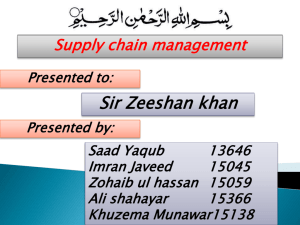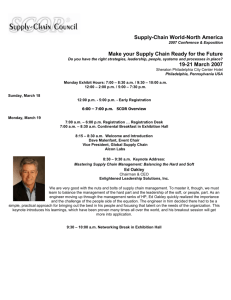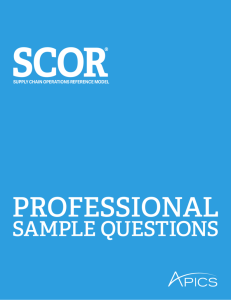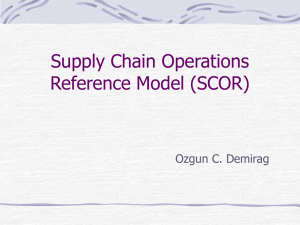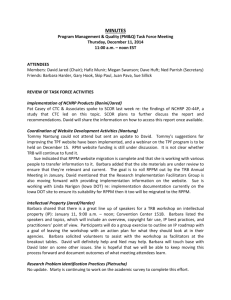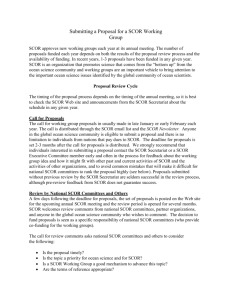SCOR Newsletter No. 8 March 2007 SCOR Newsletter No. 17
advertisement
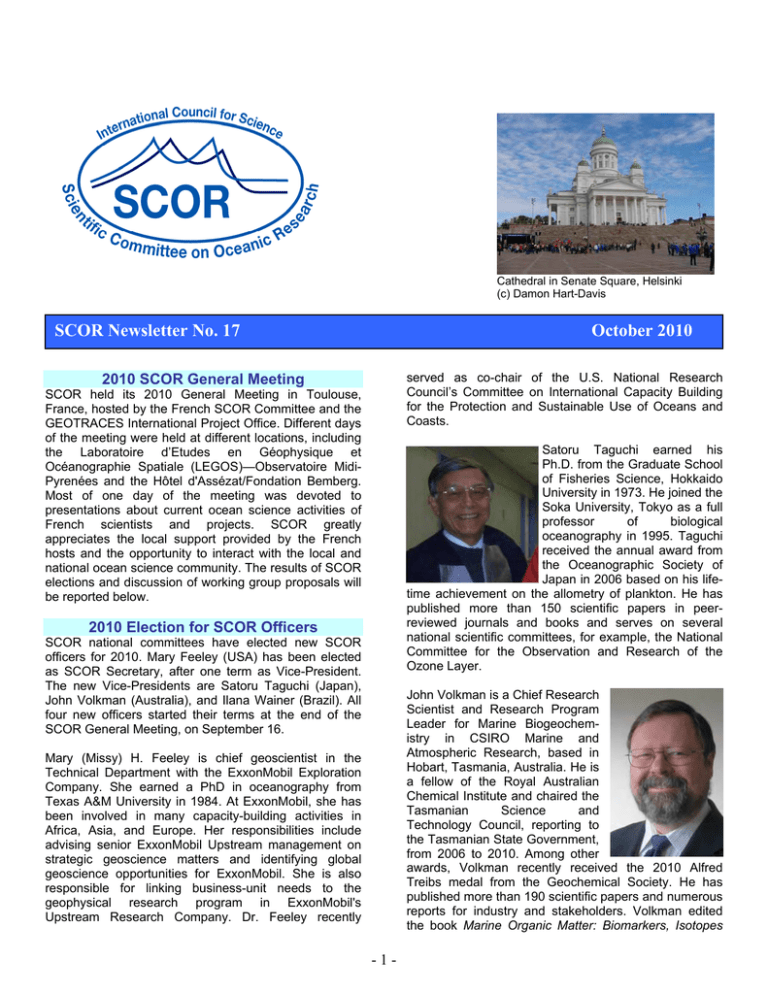
Cathedral in Senate Square, Helsinki (c) Damon Hart-Davis SCOR Newsletter No. 17 SCOR Newsletter No. 8 October 2010 March 2007 served as co-chair of the U.S. National Research Council’s Committee on International Capacity Building for the Protection and Sustainable Use of Oceans and Coasts. 2010 SCOR General Meeting SCOR held its 2010 General Meeting in Toulouse, France, hosted by the French SCOR Committee and the GEOTRACES International Project Office. Different days of the meeting were held at different locations, including the Laboratoire d’Etudes en Géophysique et Océanographie Spatiale (LEGOS)—Observatoire MidiPyrenées and the Hôtel d'Assézat/Fondation Bemberg. Most of one day of the meeting was devoted to presentations about current ocean science activities of French scientists and projects. SCOR greatly appreciates the local support provided by the French hosts and the opportunity to interact with the local and national ocean science community. The results of SCOR elections and discussion of working group proposals will be reported below. Satoru Taguchi earned his Ph.D. from the Graduate School of Fisheries Science, Hokkaido University in 1973. He joined the Soka University, Tokyo as a full professor of biological oceanography in 1995. Taguchi received the annual award from the Oceanographic Society of Japan in 2006 based on his lifetime achievement on the allometry of plankton. He has published more than 150 scientific papers in peerreviewed journals and books and serves on several national scientific committees, for example, the National Committee for the Observation and Research of the Ozone Layer. 2010 Election for SCOR Officers SCOR national committees have elected new SCOR officers for 2010. Mary Feeley (USA) has been elected as SCOR Secretary, after one term as Vice-President. The new Vice-Presidents are Satoru Taguchi (Japan), John Volkman (Australia), and Ilana Wainer (Brazil). All four new officers started their terms at the end of the SCOR General Meeting, on September 16. John Volkman is a Chief Research Scientist and Research Program Leader for Marine Biogeochemistry in CSIRO Marine and Atmospheric Research, based in Hobart, Tasmania, Australia. He is a fellow of the Royal Australian Chemical Institute and chaired the Tasmanian Science and Technology Council, reporting to the Tasmanian State Government, from 2006 to 2010. Among other awards, Volkman recently received the 2010 Alfred Treibs medal from the Geochemical Society. He has published more than 190 scientific papers and numerous reports for industry and stakeholders. Volkman edited the book Marine Organic Matter: Biomarkers, Isotopes Mary (Missy) H. Feeley is chief geoscientist in the Technical Department with the ExxonMobil Exploration Company. She earned a PhD in oceanography from Texas A&M University in 1984. At ExxonMobil, she has been involved in many capacity-building activities in Africa, Asia, and Europe. Her responsibilities include advising senior ExxonMobil Upstream management on strategic geoscience matters and identifying global geoscience opportunities for ExxonMobil. She is also responsible for linking business-unit needs to the geophysical research program in ExxonMobil's Upstream Research Company. Dr. Feeley recently -1- and DNA published by Springer in 1996. He has been an Associate Editor of the journal Organic Geochemistry since 1989. Volkman's research interests include the production and transport of organic matter in marine ecosystems, environmental pollutants, organic geochemistry of recent and ancient sediments, petroleum geochemistry, environmental genomics and the lipid biochemistry of marine animals, microalgae and bacteria. as well as providing details about SCOR’s development of the International Indian Ocean Expedition. SCOR is interested in ideas for additional reports on SCOR history from individuals who helped develop SCOR and participated in its early activities. The SCOR Secretariat is increasing the number of historical documents on the SCOR Web site, including early volumes of the SCOR Proceedings and the papers of Robert Snider, first director of the International Indian Ocean Expedition. A bibliography of documents on SCOR history can be found at http://www.scorint.org/history.htm and documents will be linked to this page as they are scanned. Ilana Wainer earned her Ph.D. from Pennsylvania State University in 1991. She is currently an Associate Professor in the Department of Physical Oceanography, at the University of São Paulo, Brazil. Wainer’s research focuses on analyzing and modeling physical oceanographic effects on climate. Specifically, she has worked on current and paleoclimate of the southeastern Brazilian shelf, Antarctic sea ice, effects of tropical variability on the North Atlantic Oscillation, and representation of Southern Ocean processes (subduction, glacial cycles, precipitation, oceanatmosphere interactions) in global climate models. Wainer has served on many national and international steering committees for climate and ocean observation programs. She served on the SCOR Executive Committee previously as a Co-opted Member. Symposia on the Ocean in a High-CO2 World The special issue of the open-access journal Biogeosciences for the Second Symposium on The Ocean in a High-CO2 World is completed and papers are freely available at http://www.biogeosciences.net/special_issue44.html. Eight bids were received to host the Third Symposium on The Ocean in a High-CO2 World. The bid from a consortium of institutions and organizations in Monterey, California (USA) was accepted. The international Planning Committee will meet in Monterey in December 2010 to review the facilities; plan the structure, topics, and invited speakers for the symposium; develop a process for abstract review and selection of submitted oral presentations; specify the products for the scientific community, policymakers, and public that will be produced from the symposium; develop a program of travel awards for early career and under-represented group scientists; and develop a plan to seek funding for travel awards for developing country scientists who may not qualify as early-career scientists. SCOR is cosponsoring this symposium with the Intergovernmental Oceanographic Commission of UNESCO, and the International Geosphere-Biosphere Programme. Other News from General Meeting Other important actions from the SCOR General Meeting include The SCOR Executive Committee approved distribution of a draft “best practices” document to national SCOR committees for comments. This document should be useful for transferring practical ideas among national committees to help them work more effectively. SCOR approved funding for a final modeling workshop planned by WG 131 on The Legacy of in situ Iron Enrichment: Data Compilation and Modeling. Capacity Development SCOR and the Leibniz Center for Tropical Marine Ecology at the University of Bremen (Germany) sponsored a meeting on capacity building for ocean research and observations in August. The purpose of the meeting was to bring together representatives of organizations interested in capacity development for ocean research and observations, to discuss their experiences with existing activities, to identify new activities, and to discuss how the organizations could work together to create a global strategy for capacity development for ocean research and observations. Representatives of SCOR, IAEA, IFS, IOC, PICES, POGO, START, and national institutions and organizations gathered in Bremen for the first meeting of this kind. The meeting report will include guidelines for capacity development approaches that could be used by SCOR History The Birth and First Years of the Scientific Committee on Oceanic Research (SCOR) was recently released and sent out to the SCOR community. This report was written by Torben Wolff, who served as a SCOR Vice President from 1980 to 1984. The report is the first SCOR History Report and documents the series of events leading up to the formation of SCOR in 1957, -2- organizations that conduct such activities. The Web site for the meeting (http://www.scor-int.org/CB_Summit.htm) provides information about the capacity-building activities of the participating organizations. Pucon, Chile in March 2011, and a potential special issue of the Journal of Plankton Research on the topic of automatic visual plankton identification. The group was mentioned in an article in the 8 September 2010 issue of Nature. Working Groups SCOR/IAPSO OceanScope Working Group (WG 133)—The OceanScope met at the International Chamber of Shipping in London in April to discuss and complete white papers on each of its terms of reference. The group will make the papers available for community comment in the near future. Six proposals were received for the 2010 call for SCOR Working Groups and one of the proposals was selected for start in 2011, based on availability of finances: Modern Planktic Foraminifera and Ocean Changes. This group is intended to (1) synthesize the state of the science of modern planktic foraminifera; (2) provide guidelines (cookbooks) in terms of species identification, experimental setup for culture studies, laboratory treatment prior to geochemical analysis and identify existing gaps in the available knowledge in order to direct future research; and (3) establish an active Web-based network in cooperation with ongoing research programs and projects to guarantee an open-access worldwide dissemination of results, data, and research plans. The group will document its work in a special issue of an open-access journal in connection with a specialized symposium on thermohaline circulation and ocean acidification, during an AGU or EGU conference, ideally held at the joint EGU/AGU meeting (envisaged for 2013 or 2014). Four other working groups have published papers or special issues as a result of their work in recent months: WGs 126, 128, 134 and 136. SCOR WG 126 on Role of Viruses in Marine Ecosystems—This group produced the first eBook by ASLO, the Manual of Aquatic Viral Ecology (see http://aslo.org/books/mave/), sponsored by the Gordon and Betty Moore Foundation. This freely available book is designed to help standardize methods in this maturing field. SCOR WG 128 on Natural and Human-Induced Hypoxia and Consequences for Coastal Areas—This group recently completed its special issue of the journal Biogeosciences, with 10 review papers that describe the state of the science in the area of hypoxia. Biogeosciences is an open-access journal of the European Geosciences Union. The special issue is available at http://www.biogeosciences.net/special_issue34.html. SCOR WG 134 on The Microbial Carbon Pump in the Ocean—This group got off to a fast start after its first meeting by publishing a paper in Nature Reviews Microbiology as a foundation for the group’s work. A recent Science News Focus article (Science 328:1476-1477, 2010) features the microbial carbon pump: its origin, rationale, implications, applications, impacts, as well as prospects. The second WG 134 meeting will be held immediately after the ASLO meeting in Puerto Rico on 18-20 Feb. 2011. One focus of the meeting will be to consider experimental designs to test the effects of the microbial carbon pump. At the preceding ASLO Aquatic Sciences Meeting, the group has prepared a special session on “Microbial Carbon Pump: A multidisciplinary focus on origins, cycling and storage of DOM in the ocean”, chaired by G. Kattner, N. Jiao, F. Azam and S. Wilhelm. Two working groups met since the April SCOR Newsletter: WGs 130 and WG 133. SCOR WG 130 on Automatic Plankton Visual Identification—WG 130 held its final SCOR-funded meeting in Villefranche-sur-Mer, France on 25-27 May. In the past year, there has been an increase in the use of semi-automatic methods for plankton identification, for example, instruments that are coupled to automatic image analysis and specimen identification software. In addition, several studies have been completed by members of SCOR WG 130 that explore issues of instrument inter-calibration, the exchange of data among users of different automatic analysis toolsets, and the potential use of non-linear matched-filters for speciesspecific identifications in the field. It is anticipated that these will be published in due course. A series of dissemination activities is taking place that advertise the outputs of WG 130 to the wider community, including a special session at the ASLO Summer 2010 conference at Santa Fe (June 2010), a one-day workshop at the Zooplankton Productivity Symposium (ZPS) meeting in -3- with the first Imbizo, this meeting had three parallel themes: SCOR/WCRP/IAPSO WG 136 on Climatic Importance of the Greater Agulhas System—This group published a description of their work in EOS and has begun planning a workshop in Africa that will focus on capacity building and will bring together scientists from east and southern Africa who are interested in the dynamics of the Agulhas Current and how it affects regional and global science. 1. The effect of varying element ratios on community structure at low trophic levels and food quality at mid and high trophic levels. 2. Large-scale regional comparisons of marine biogeochemistry and ecosystem processes research approaches and results. 3. Sensitivity of marine food webs and biogeochemical cycles to enhanced stratification. Large-Scale Ocean Research Projects SCOR/IOC GEOHAB Program—GEOHAB hosted an open science meeting (OSM) on the topic of benthic HABs in Honolulu, Hawaii (USA) on 21-24 June 2010. The purpose of this meeting was to develop a community consensus about priority research topics on benthic harmful algal blooms (B-HABs). These species create some of the most extensive human health problems of any HAB species. For example, fish can accumulate toxin from HAB species such as Gambierdiscus as they eat macroalgae on which this species grows, leads to ciguatera when humans eat the tainted fish. A newer threat comes from benthic dinoflagellates, such as Ostreopsis, that release airborne toxin that causes respiratory distress. The organizing committee for the OSM is working on the research plan from the meeting. GEOHAB sponsored a training workshop on isolation and identification of B-HAB species following the OSM. Twenty individuals participated in the workshop. It is expected that special issues or papers will result from the work of these breakout groups, similar to the special issue of Deep-Sea Research II on Ecological and Biogeochemical Interactions in the Dark Ocean that resulted form the first Imbizo.1 SCOR GEOTRACES Project—The GEOTRACES SSC and Data Management Committee met in Toulouse, France following the SCOR General Meeting. The GEOTRACES transect phase of the project, launched in February 2010, is in full swing, with major U.S. and UK cruises scheduled to leave port in October, following transects earlier in the year by Japan and the Netherlands. The new GEOTRACES Web site has been launched (see http://www.geotraces.org/). SCOR/IGGP/IOC GLOBEC Project—Manuel Barange, the former GLOBEC Executive Director, presented the final report from this highly successful project to the SCOR meeting in Toulouse. Meeting participants expressed their appreciation to Barange and all the volunteers who had made GLOBEC a success, and Barange thanked SCOR for the substantial support provided over the life of the project. A resolution regarding the completion of GLOBEC was issued last year and is available at http://www.scorint.org/2009EC/SCOR_Resolution_on_GLOBEC.pdf. The International Ocean Colour Coordination Project (IOCCG) and GEOHAB are co-sponsoring a new group to produce a manual to document applications of remote sensing to detection and identification of HABs. This group held its first meeting in August in South Africa. GEOHAB has produced two new reports and a special issue of the Journal of Marine Systems (JMS) in the past few months. The OSM report from the Fjords and Coastal Embayments project was published earlier this year and provides guidance to the HAB research community for comparative research on HABs in semiclosed coastal systems that are not characterized by eutrophication. Scientists from Asia also produced a plan for coordinated HAB research in their region. Finally, a special issue of JMS documents the status of modeling activities for HABs in various systems. SCOR/IODE/MBLWHOI Library Project on Data Publication The MBLWHOI Library joined SCOR and the International Oceanographic Data and Information Exchange (IODE) in the data publication activity that was started in 2008. Following the April meeting of the group, a challenge was issued to data centers: SCOR/IGBP/WCRP/CACGP SOLAS Project—SOLAS continues work on its seven mid-term strategy themes; white papers for most themes are available on the SOLAS Web site. SOLAS has begun planning for its 2011 Summer School. The deadline for applications is 15 November (see http://www.solasint.org/summerschool/welcome.html). Marine libraries, data centers, and ocean scientists were invited to self-organize to accomplish the following goals: SCOR/IGBP IMBER Project—The second IMBER Imbizo was held in Crete, Greece on 10-14 October (see https://www.confmanager.com/main.cfm?cid=1683). As 1 Establish cooperation between a data center and library, with a marine science institution or Volume 57, Issue 16, Pages 1-1592 (2010), edited by Deborah Steinberg and Dennis Hansell. -4- Zhang, J. and D. Gilbert (eds). Special issue of Biogeosciences on Hypoxia. http://www.biogeosciences.net/special_issue34.html - SCOR WG 128 department, to help scientists link their data to their publications. Select one to a few papers from the marine science institution to test for data publication. Data center to work with the author(s) to develop metadata for figures and tables in a paper, using Dublin Core, Darwin Core, etc. Data center to help put the data into machinereadable format. Library to apply for DOI for the paper (or for each figure and table). Library to establish system for storage of data sets associated with the paper in their DSpace archive. Scientist to submit a paper for publication in a traditional journal. Partners to report on their experience to SCOR/IODE/MBLWHOI Library group. SCOR Annual Meetings 2011—The Finnish SCOR Committee has invited SCOR to hold its 2011 Executive Committee meeting in Helsinki, Finland on 12-15 September. 2012—The 2012 SCOR General Meeting will be held in Halifax, Nova Scotia, Canada. 2013—SCOR is seeking a Southern Hemisphere host for its 2013 Executive Committee meeting. 2014—SCOR has accepted an offer from the German SCOR Committee to hold its 2014 General Meeting in Bremen, Germany. The results of this challenge will be reported at meetings in Cape Town and San Francisco later this year. For additional information about SCOR activities, please see the SCOR Web site: http://www.scorint.org. Publications Beal, L.. and A. Biastoch. 2010. Improving understanding of the Agulhas Current and its global climate impacts. EOS 91:163. – SCOR/WCRP/IAPSO WG 136 Gattuso, J.-P., J. Orr, S. Pantoja, H.-O. Pörtner, U. Riebesell, and T. Trull (eds.). Special issue of Biogeosciences on The ocean in the high-CO2 world II. http://www.biogeosciences.net/special_issue44.html GEOHAB. 2010. Global Ecology and Oceanography of Harmful Algal Blooms, GEOHAB Core Research Project: HABs in Fjords and Coastal Embayments. A. Cembella, L. Guzmán, S. Roy, J. Diogène (Eds.), IOC and SCOR, Paris, France and Newark, Delaware USA, 57 pp GEOHAB. 2010. Global Ecology and Oceanography of Harmful Algal Blooms, Harmful Algal Blooms in Asia. K. Furuya, P.M. Glibert, M. Zhou and R. Raine (eds.), IOC and SCOR, Paris and Newark, Delaware. 68 pp. Glibert, P.M., J.I Allen, A.F. Bouwman, C.W. Brown, K.J. Flynn, A.J. Lewitus, and C.J. Madden. 2010. Modeling of HABs and eutrophication: Status, advances, challenges. Journal of Marine Systems – SCOR/LOICZ WG 132. Jiao, N., G.J. Herndl, D.A. Hansell, R. Benner, G. Kattner, S.W. Wilhelm, D.L. Kirchman, M.G. Weinbauer, T. Luo, F. Chen, and F. Azam. 2010. Microbial production of recalcitrant dissolved organic matter: long-term carbon storage in the global ocean. Nature Reviews Microbiology 8:593599, doi:10.1038/nrmicro2386 – WG 134 Wolff, T. 2010. The Birth and First Years of the Scientific Committee on Oceanic Research (SCOR). SCOR History Report #1. Scientific Committee on Oceanic Research, Newark, Delaware, USA SCOR Secretariat College of Earth, Ocean, and Environment Robinson Hall University of Delaware Newark, DE 19716 USA Tel: +1-302-831-7011 Fax: +1-302-831-7012 To reach Secretariat staff, please call the number above or send an email to Ed Urban (Ed.Urban@scor-int.org) or Lora Carter (Lora.Carter@scor-int.org). Acronyms: AGU CACGP EGU GEOHAB GLOBEC IAEA IAPSO IFS IGBP IOC IODE LOICZ LEGOS MBL OSM -5- American Geophysical Union Commission on Atmospheric Chemistry and Global Pollution European Geosciences Union Global Ecology and Oceanography of Harmful Algal Blooms Project Global Ocean Ecosystem Dynamics project International Atomic Energy Agency International Association for the Physical Sciences of the Ocean International Foundation for Science International Geosphere – Biosphere Programme Intergovernmental Oceanographic Commission of UNESCO International Oceanographic Data and Information Exchange (IOC/UNESCO) Land-Ocean Interactions in the Coastal Zone project Laboratoire d'Etudes en Géophysique et Océanographie Spatiales Marine Biological Laboratory (Woods Hole, Massachusetts, USA) open science meeting PICES SCOR SOLAS START WCRP WG WHOI North Pacific Marine Sciences Organization Scientific Committee on Oceanic Research Surface Ocean – Lower Atmosphere Study Global Change System for Analysis, Research, and Training World Climate Research Programme working group Woods Hole Oceanographic Institution Acknowledgements of Figures: Page 1— Cathedral in Senate Square, Helsinki (see http://gallery.hd.org/_c/places-andsights/_more2003/_more08/Finland-Helsinki-Senate-Squarecathedral-singers-on-stage-to-left-chirpy-song-peoplewatching-1-DHD.jpg.html) Page 3— Thalamophora by Ernst Haeckel in Kunstformen der Natur (1904) (see http://commons.wikimedia.org/wiki/File:Haeckel_Thalamophora _81.jpg). -6-
